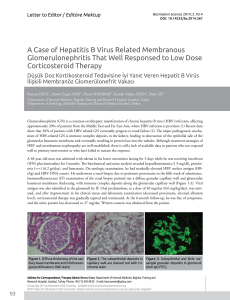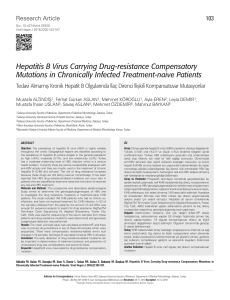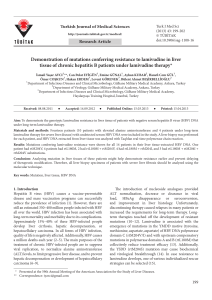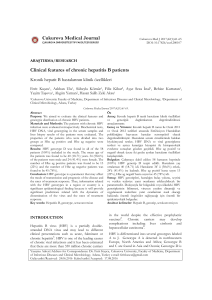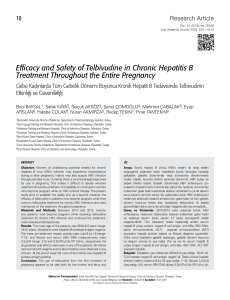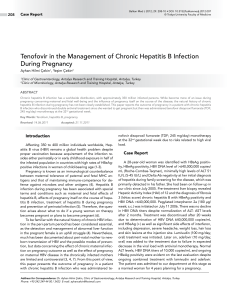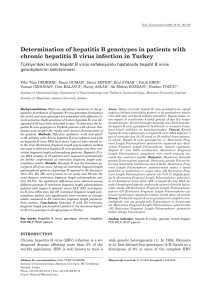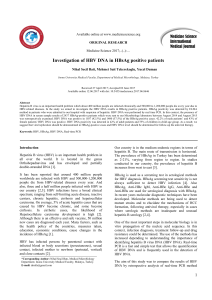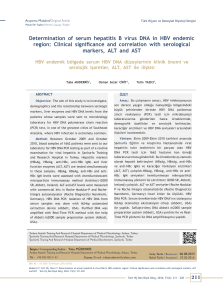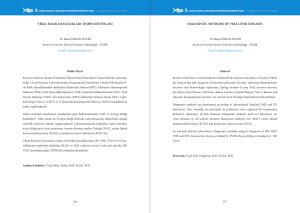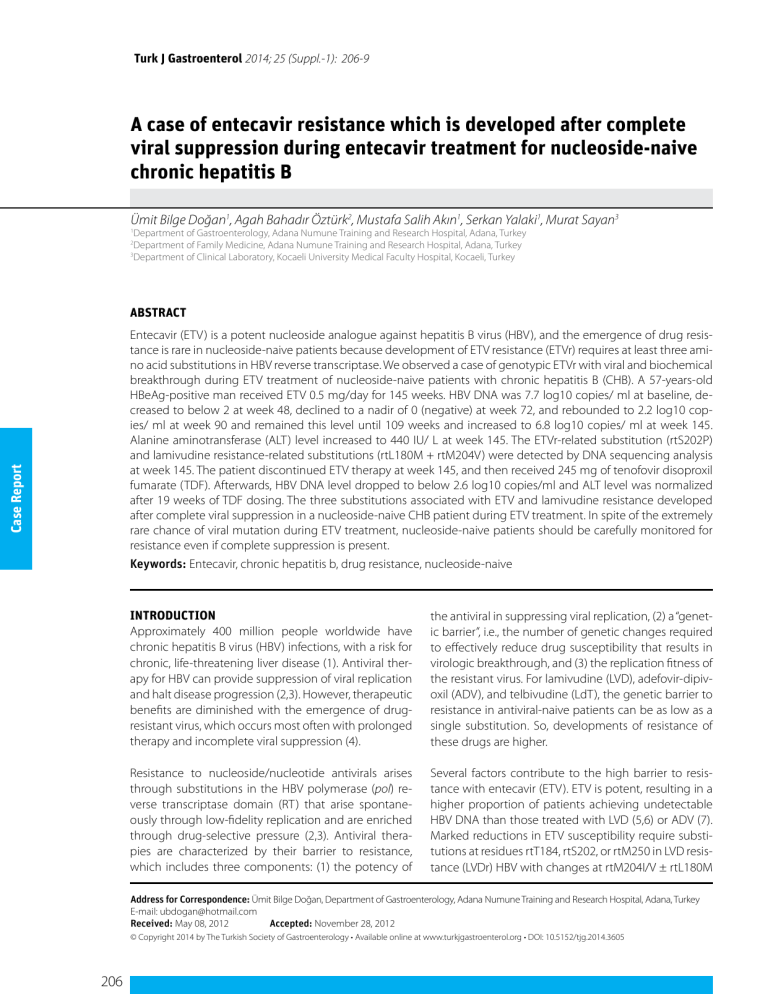
Turk J Gastroenterol 2014; 25 (Suppl.-1): 206-9
A case of entecavir resistance which is developed after complete
viral suppression during entecavir treatment for nucleoside-naive
chronic hepatitis B
xxxxxxxxxxxxxxx
Ümit Bilge Doğan1, Agah Bahadır Öztürk2, Mustafa Salih Akın1, Serkan Yalaki1, Murat Sayan3
Department of Gastroenterology, Adana Numune Training and Research Hospital, Adana, Turkey
Department of Family Medicine, Adana Numune Training and Research Hospital, Adana, Turkey
3
Department of Clinical Laboratory, Kocaeli University Medical Faculty Hospital, Kocaeli, Turkey
1
2
ABSTRACT
Case Report
Entecavir (ETV) is a potent nucleoside analogue against hepatitis B virus (HBV), and the emergence of drug resistance is rare in nucleoside-naive patients because development of ETV resistance (ETVr) requires at least three amino acid substitutions in HBV reverse transcriptase. We observed a case of genotypic ETVr with viral and biochemical
breakthrough during ETV treatment of nucleoside-naive patients with chronic hepatitis B (CHB). A 57-years-old
HBeAg-positive man received ETV 0.5 mg/day for 145 weeks. HBV DNA was 7.7 log10 copies/ ml at baseline, decreased to below 2 at week 48, declined to a nadir of 0 (negative) at week 72, and rebounded to 2.2 log10 copies/ ml at week 90 and remained this level until 109 weeks and increased to 6.8 log10 copies/ ml at week 145.
Alanine aminotransferase (ALT) level increased to 440 IU/ L at week 145. The ETVr-related substitution (rtS202P)
and lamivudine resistance-related substitutions (rtL180M + rtM204V) were detected by DNA sequencing analysis
at week 145. The patient discontinued ETV therapy at week 145, and then received 245 mg of tenofovir disoproxil
fumarate (TDF). Afterwards, HBV DNA level dropped to below 2.6 log10 copies/ml and ALT level was normalized
after 19 weeks of TDF dosing. The three substitutions associated with ETV and lamivudine resistance developed
after complete viral suppression in a nucleoside-naive CHB patient during ETV treatment. In spite of the extremely
rare chance of viral mutation during ETV treatment, nucleoside-naive patients should be carefully monitored for
resistance even if complete suppression is present.
Keywords: Entecavir, chronic hepatitis b, drug resistance, nucleoside-naive
INTRODUCTION
Approximately 400 million people worldwide have
chronic hepatitis B virus (HBV) infections, with a risk for
chronic, life-threatening liver disease (1). Antiviral therapy for HBV can provide suppression of viral replication
and halt disease progression (2,3). However, therapeutic
benefits are diminished with the emergence of drugresistant virus, which occurs most often with prolonged
therapy and incomplete viral suppression (4).
the antiviral in suppressing viral replication, (2) a “genetic barrier”, i.e., the number of genetic changes required
to effectively reduce drug susceptibility that results in
virologic breakthrough, and (3) the replication fitness of
the resistant virus. For lamivudine (LVD), adefovir-dipivoxil (ADV), and telbivudine (LdT), the genetic barrier to
resistance in antiviral-naive patients can be as low as a
single substitution. So, developments of resistance of
these drugs are higher.
Resistance to nucleoside/nucleotide antivirals arises
through substitutions in the HBV polymerase (pol) reverse transcriptase domain (RT) that arise spontaneously through low-fidelity replication and are enriched
through drug-selective pressure (2,3). Antiviral therapies are characterized by their barrier to resistance,
which includes three components: (1) the potency of
Several factors contribute to the high barrier to resistance with entecavir (ETV). ETV is potent, resulting in a
higher proportion of patients achieving undetectable
HBV DNA than those treated with LVD (5,6) or ADV (7).
Marked reductions in ETV susceptibility require substitutions at residues rtT184, rtS202, or rtM250 in LVD resistance (LVDr) HBV with changes at rtM204I/V ± rtL180M
Address for Correspondence: Ümit Bilge Doğan, Department of Gastroenterology, Adana Numune Training and Research Hospital, Adana, Turkey
E-mail: [email protected]
Received: May 08, 2012 Accepted: November 28, 2012
© Copyright 2014 by The Turkish Society of Gastroenterology • Available online at www.turkjgastroenterol.org • DOI: 10.5152/tjg.2014.3605
206
Doğan et al. A case of entecavir resistance
Turk J Gastroenterol 2014; 25 (Suppl.-1): 206-9
directly sequenced on ABI PRISM 310 Genetic Analyzer equipment using the DYEnamic ET Terminator Cycle Sequencing Kit
(Amersham Pharmacia Biotech Inc., Piscataway, USA). For cycle
sequencing, we used the following thermal protocol: 35 cycles
consisting of 95°C for 20 s, 50°C for 25 s, and finally 60°C for 2
min. The reverse primer was used as the sequencing primer
at a final concentration of 0.5 μM. Electropherogram-obtained
sequences were assembled using Vector NTI v5.1 (InforMax, Invitrogen Life Science Software, Frederick, MD, USA).
Table 1. Baseline characteristics of patient
So, it has been reported that the development of ETVr in nucleoside-naive patients is very rare, even after 5 years of therapy
(13). Recently, however, rare cases of ETVr, which developed
in nucleoside-naive patients, have been reported (14-16). We
also observed one patient who developed ETVr-associated
HBV RT substitutions, followed by virologic and biochemical
breakthrough after complete viral suppression in longterm ETV
treatment of nucleoside-naive CHB patients. In this study, we
report this case in detail.
CASE REPORT
A 57-years-old Turkish man with CHB received a checkup in
April 2009, and was found to be seropositive for hepatitis B surface antigen (HBsAg) with normal liver enzymes. He has a history of asthma and use of inhaling corticosteroids for 9 years.
He didn’t drink and smoke. Hepatitis B e antigen (HBeAg) was
positive and serum HBV DNA was 7.7 log10 copies/mL (Cobas
AmpliPrep-Taqman HBV Test, Roche Diagnostics, Mannheim,
Germany). Other baseline characteristics are shown in Table 1.
He was diagnosed with CHB by percutaneous liver biopsy (mild
activity [7] and severe fibrosis [F3], according to Knodell score) at
another hospital in May 2009. At this time, treatment with ETV
was started at 0.5 mg/day. After the start of ETV, the serum HBV
DNA level decreased to below 2 log10 copies/ml at week 48 and
declined to a nadir of 0 copies/ ml at week 72 of ETV treatment.
Thereafter, HBV DNA level rebounded to 2.2 log10 copies/ml at
week 90 and remained this level until 109 weeks and increased
to 6.8 log10 copies/ ml at week 145. ALT levels increased from 19
IU/L at week 122 to 440 IU/L at week 145. The patient discontinued ETV therapy at week 145, and then received 245 mg of
tenofovir disoproxil fumarate (TDF). Afterwards, HBV DNA level
dropped to below 2.6 log10 copies/ml and ALT level was normalized after 19 weeks of TDF dosing (Figure 1).
A pair of primers was designed (forward: 5’-TC-GTGGTGGACTTCTCTCAATT-3’ and reverse: 5’-CGTTGA-CAGACTTTCCAATCAAT-3’) for amplification of the HBV pol region for the
analysis of HBV drug resistance. PCR conditions were 95°C for
15 min, followed by 45 cycles consisting of 95°C for 45 s, 56°C
for 45 s, and 72°C for 45 s. The final primer concentration was
0.3 μM, and the HBV amplicon size was 742 bp. All PCR products were purified using the High Pure PCR Product Purification Kit (Roche Diagnostics GmbH, Mannheim, Germany) and
Normal range
Unit
Case
Age
-
-
57
Gender
-
-
Male
74-106
mg/dL
104
Blood Urea Nitrogen
6-20
mg/dL
12
Creatine
0-0.9
mg/dL
0.9
Aspartate Aminotransferase
0-31
IU/L
28
ALT
0-33
IU/L
31
Alkaline Phosphatase
0-98
IU/L
78
GGT
0-36
IU/L
103
T. Bil
0-1.1
mg/dL
1.3
Albumin
3.5-5.2
g/dL
4.7
Hb
12.3-15.3
g/dL
15
WBC
4.4-11.3
103/µ
7.5
Plt
136-380
103/µ
145
Prothrombin time
12-15
second
13.8
INR
0.8-1.2
-
1.18
AFP
0-5.8
ng/ml
14
ANA
Negative
-
Negative
AMA
Negative
-
Negative
SMA
Negative
-
Negative
HBsAg
0-0.9
IU/mL
250 (Positive)
HBeAg
0-1
S/CO
18.7 (Positive)
Anti-HBe
0-50
S/CO
1.8 (Negative)
Anti-HBs
0-10
IU/mL
0 (Negative)
Anti-HCV
0-0.9
IU/mL
0 (Negative)
Anti-Delta
Negative
IU/mL
Negative
HBV DNA (PCR)
Negative
Log10 copies/mL
7.7
HBV genotype
-
-
D
HBV subgenotype
-
-
D2
Normal
-
HAI 7, F 3 (Knodell)
Fasting blood glucose
Liver histology
Case Report
(8,9). Thus, the genetic barrier to ETV resistance (ETVr) involves
multiple substitutions. In-vitro studies demonstrated that the
highest levels of phenotypic resistance, leading to virologic
breakthrough, require both the rtM204V and rtL180M LVDr
substitutions with at least one ETVr substitution (8,10). Additionally, ETVr HBV exhibits impaired replication fitness (9). Thus,
the finding that ETVr has been rarely observed in nucleosidenaive patients (11,12) is likely due to a combination of a high
genetic barrier, potent viral suppression, and reduced fitness of
resistant viruses.
INR: International normalized ratio; HbsAg: hepatitis B surface antigen; HBV: hepatitis B
virus; HCV: hepatitis C virus; PCR: polymerase chain reaction; ALT: alanine Aminotransferase; GGT: gamma-glutamyl transpeptidase; T. Bil: total bilirubine; Hb: hemoglobine; WBC:
white blood cells; AFP: alpha-fetoprotein; ANA: anti-nuclear antibody; AMA: anti-mitochondrial antibody; ASMA: anti-smooth muscle antibody
207
Doğan et al. A case of entecavir resistance
Turk J Gastroenterol 2014; 25 (Suppl.-1): 206-9
Figure 1. Clinical course of case.
The LVDr-related substitutions rtL180M and rtM204V, as well as
ETVr-related substitution rtS202G, were detected at week 145.
Case Report
DISCUSSION
Treatment of CHB has evolved markedly with the introduction of nucleoside-analogue antivirals, that is, LVD, ADV, ETV,
and LdT, to clinical practice. The most important limitation of
long-term nucleoside analogue treatment for CHB is the emergence of drug resistant mutations in HBV followed by viral
breakthrough and hepatitis flare (3). The most common mutation associated with LVDr involves substitution of methionine
in the tyrosine-methionine-aspartate-aspartate (YMDD) motif
of the HBV DNA pol gene RT domain with valine or isoleucine
(rtM204V/I), with or without a leucine-to-methionine substitution in an upstream region (rtL180M) (17). It was reported that
LVDr was detected at a rate of 14 to 32% after 1 year and 60 to
70% after 5 years of LVD treatment (3). LdT resistance also arises
at the YMDD motif and has been reported in the context of
virologic breakthrough, at 22% and 9% over 2 years in patients
who are positive and negative, respectively, for the hepatitis B e
antigen (11,12). The substitutions conferring resistance to ADV
are asparagine to threonine (rtN236T) and alanine to valine or
threonine (rtA181V/T) (20), and the cumulative probability of
ADV resistance with elevation of HBV DNA level has been reported to be 20% at 5 years in HBeAg-negative patients (21)
and as high as 42% in HBeAg-positive patients (22).
Entecavir displays several properties for consideration as the
first-line nucleoside analogue because of its potent antiviral
activity and a lower frequency of drug resistance than LVD,
ADV, or LdT (23). In the case of ETV, it has been reported that
resistance to the drug requires at least one of three substitutions in HBV RT, that is, rtT184, rtS202, and rtM250, as well as
LVDr-related substitutions rtL180M and rtM204V (24).
208
There is a high genetic barrier to resistance to ETV in nucleoside-naive patients and <1% experience virologic breakthrough with ETVr through 5 years of therapy (13). In that study,
ETVr substitutions were detected in only three nucleosidenaive patients (3 of 663). Two of these patients with wild-type
virus at baseline developed rtM204V+rtL180M and rtS202G
simultaneously. They did not achive undetectable HBV-DNA
(<300 copies/mL) on ETV. Only HBeAg-negative one patient
with the rtM204I substitution achieved undetectable HBV DNA
(<300 copies/mL) in that study. So, it was concluded that, ETVr
changes combined with only the rtM204I LVDr substitutions
displayed lower levels of phenotypic ETV resistance (25).
The results of a parallel survey of surveillance conducted in
Japan in which nucleoside-naive patients received the 0.5 mg
dosage of ETV for 3 years yielded only one of 66 patients who
developed genotypic resistance (1.7%) (12).
Simultaneous emergence of all three resistance substitutions
has been noted in other reports of ETVr.(14). In that report,
ETVr developed in a nucleoside-naive patient with genotype
H of HBV, which did not achieve undetectable HBV DNA levels.
In another report, ETVr have been emerged in two Japanese
nucleoside-naive CHB patients after prolonged therapy and incomplete suppression (15). Finally, in a recent report, the three
substitutions associated with ETV and LVD resistance has been
developed simultaneously without complete suppression in a
nucleoside-naive CHB patient after extended therapy (16).
Entecavir resistance has been attributed to high pretreatment
viral loads and persistently detectable HBV-DNA by PCR during
the treatment course in all reports of ETVr. It is believed that
some subpopulations of HBV that proliferate very actively and
are not completely suppressed by ETV may have a chance of
Doğan et al. A case of entecavir resistance
being selected for the resistance substitutions required for ETV
virologic failure. Phenotypic analyses of samples associated
with virologic breakthrough confirmed that ETV susceptibility
correlates with the spectrum of these additional substitutions
conferring genotypic resistance and the increased level of circulating HBV DNA (25). Thus, all of the ETVr cases had incomplete viral suppression except one HBeAg-negative patient
presented in the study of Tenney et al (13). Our patient also had
complete viral suppression before the development of ETVr.
The three substitutions associated with ETV and LVD resistance
developed after complete viral suppression. So, circulating HBV
DNA could not a reason for ETVr. We could not perform DNA
sequence analysis before the HBV treatment. So we dont know
whether baseline rtM204I substitution was present or not as in
the study of Tenney et al (13).
CONCLUSION
In this article, we report a case with confirmed genotypic resistance to ETV, virologic and biochemical breakthrough during
long-term ETV treatment for nucleoside-naive CHB patients.
The present case of ETV resistance is particularly notable for its
emergence in a case with complete viral suppression, which
is rare. To our knowledge, this is the second report of emerging resistance to ETV in a nucleoside-naive patient after complete viral supression. In spite of the extremely rare chance of
viral mutation during ETV treatment, nucleoside-naive patients
should be carefully monitored for resistance even if complete
suppression is present.
9.
10.
11.
12.
13.
14.
15.
16.
17.
Conflict of Interest: No conflict of interest was declared by
the authors.
REFERENCES
1. Shepard CW, Simard EP, Finelli L, et al. Hepatitis B virus infection:
epidemiology and vaccination. Epidemiol Rev 2006; 28: 112-25.
2. Pawlotsky JM, Dusheiko G, Hatzakis A, et al. Virologic monitoring
of hepatitis B virus therapy in clinical trials and practice: recommendations for a standardized approach. Gastroenterology 2008;
134: 405-15.
3. Lok A, McMahon BJ. Chronic hepatitis B. Hepatology 2007; 45:
507-39.
4. Richman DD. The impact of drug resistance on the effectiveness
of chemotherapy for chronic hepatitis B. Hepatology 2000; 32:
866-7.
5. Lai CL, Shouval D, Lok AS, et al. Entecavir versus lamivudine for
patients with HBeAg-negative chronic hepatitis B. N Engl J Med
2006; 354: 1011-20.
6. Chang TT, Gish RG, de Man R, et al. A comparison of entecavir and
lamivudine for HBeAg-positive chronic hepatitis B. N Engl J Med
2006; 354: 1001-10.
7. Leung N, Peng C-Y, Sollano L, et al. Entecavir results in higher
HBV DNA reduction vs adefovir in chronically infected HBeAg(+)
antiviral-naive adults: 24 wk results (E.A.R.L.Y. Study). Hepatology
2006; 44 (4 Suppl. 1): 554A.
8. Baldick CJ, Eggers BJ, Fang J, et al. Hepatitis B virus quasispecies
susceptibility to entecavir confirms the relationship between ge-
18.
19.
20.
21.
22.
23.
24.
25.
notypic resistance and patient virologic response. J Hepatol 2008;
48: 895-902.
Baldick CJ, Tenney DJ, Mazzucco CE, et al. Comprehensive evaluation of hepatitis B virus reverse transcriptase substitutions associated with entecavir resistance. Hepatology 2008; 47: 1473-82.
Tenney DJ, Rose RE, Baldick CJ, et al. Two-year assessment of entecavir resistance in lamivudine refractory hepatitis B virus patients
reveals different clinical outcomes depending on the resistance
substitutions present. Antimicrob Agents Chemother 2007; 51:
902-11.
Colonno RJ, Rose R, Baldick CJ, et al. Entecavir resistance is rare in
nucleoside naive patients with hepatitis B. Hepatology 2006; 44:
1656-65.
Yokosuka O, Kumada H, Toyota J, et al. Three year assessment of
entecavir (ETV) resistance in nucleoside naive and lamivudine
(LVD) refractory Japanese patients with chronic hepatitis B (CHB).
Hepatol Int 2008; 2: A161.
Tenney DJ, Rose RE, Baldick CJ, et al. Long-term monitoring shows
Hepatitis B Virus Resistance to entecavir in nucleoside-naive patients is rare through 5 years of therapy. Hepatology 2009; 49:
1503-14.
Suzuki F, Akuta N, Suzuki Y, et al. Selection of a virus strain resistant to entecavir in a nucleoside-naive patient with hepatitis B of
genotype H. J Clin Virol 2007; 39: 149-52.
Kobashi H, Fujioka S, Kawaguchi M, et al. Two cases of development of entecavir resistance during entecavir treatment for nucleoside-naive chronic hepatitis B. Hepatol Int. 2009; 3: 403-10.
Lee HW, Kim HJ, Hong SP, et al. Simultaneous Emergence of Entecavir Resistance Mutations in a Nucleoside-Naive Chronic Hepatitis B Patient. Intervirology 2012; 55: 3804.
Lai CL, Chien RN, Leung NW, et al. A one year trial of lamivudine
for chronic hepatitis B. N Engl J Med 1998; 339: 61-8.
Lai CL, Gane E, Hsu CW, et al. Two-year results from the GLOBE trial
in patients with hepatitis B: greater clinical and antiviral efficacy
for telbivudine (LdT) vs. lamivudine. Hepatology 2006; 44: 222A.
Standring DN, Seifer M, Patty A, et al. HBV resistance determination from the telbivudine globe registration trial. J Hepatol 2006;
44: S191.
Angus P, Vaughan R, Xiong S, et al. Resistance to adefovir dipivoxil
therapy associated with the selection of a novel mutation in the
HBV polymerase. Gastroenterology 2003; 125: 292-7.
Hadziyannis SJ, Tassopoulos NC, Heathcote EJ, et al. Adefovir Dipivoxil 438 Study Group. Longterm therapy with adefovir dipivoxil
for HBeAg-negative chronic hepatitis B for up to 5 years. Gastroenterology 2006; 131: 1743-51.
Hepsera (Adefovir dipivoxil) current US package insert. CA: Gilead
Sciences. p. 3
Keeffe EB, Dieterich DT, Han SH, et al. A treatment algorithm for the
management of chronic hepatitis B virus infection in the United
States: an update. Clin Gastroenterol Hepatol 2006; 4: 936-62.
Tenney DJ, Levine SM, Rose RE, et al. Clinical emergence of entecavir-resistant hepatitis B virus requires additional substitutions
in virus already resistant to lamivudine. Antimicrob Agents Chemother 2004; 48: 3498-507.
Baldick CJ, Eggers BJ, Fang J, et al. Hepatitis B virus quasi-species
susceptibility to entecavir confirms the relationship between genotypic resistance and patient virologic response. J Hepatol 2008;
48: 895-902.
Case Report
Turk J Gastroenterol 2014; 25 (Suppl.-1): 206-9
209

